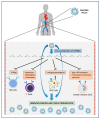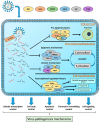Non-Coding RNAs: Strategy for Viruses' Offensive
- PMID: 32927786
- PMCID: PMC7549346
- DOI: 10.3390/ncrna6030038
Non-Coding RNAs: Strategy for Viruses' Offensive
Abstract
The awareness of viruses as a constant threat for human public health is a matter of fact and in this resides the need of understanding the mechanisms they use to trick the host. Viral non-coding RNAs are gaining much value and interest for the potential impact played in host gene regulation, acting as fine tuners of host cellular defense mechanisms. The implicit importance of v-ncRNAs resides first in the limited genomes size of viruses carrying only strictly necessary genomic sequences. The other crucial and appealing characteristic of v-ncRNAs is the non-immunogenicity, making them the perfect expedient to be used in the never-ending virus-host war. In this review, we wish to examine how DNA and RNA viruses have evolved a common strategy and which the crucial host pathways are targeted through v-ncRNAs in order to grant and facilitate their life cycle.
Keywords: immune evasion; miRNA mimicry; viral circRNA; viral non-coding RNA.
Conflict of interest statement
The authors declare no conflict of interest.
Figures


Similar articles
-
Non-coding RNAs in virology: an RNA genomics approach.Biotechnol Genet Eng Rev. 2018 Apr;34(1):90-106. doi: 10.1080/02648725.2018.1471642. Epub 2018 Jun 4. Biotechnol Genet Eng Rev. 2018. PMID: 29865927 Review.
-
Implications of non-coding RNAs in viral infections.Rev Med Virol. 2016 Sep;26(5):356-68. doi: 10.1002/rmv.1893. Epub 2016 Jul 12. Rev Med Virol. 2016. PMID: 27401792 Review.
-
Role of Non-coding RNAs in Interactions between Host and Influenza Virus.Bing Du Xue Bao. 2017 Jan;33(1):108-115. Bing Du Xue Bao. 2017. PMID: 30702830 Review. Chinese, English.
-
A transcriptomic profile of topping responsive non-coding RNAs in tobacco roots (Nicotiana tabacum).BMC Genomics. 2019 Nov 14;20(1):856. doi: 10.1186/s12864-019-6236-6. BMC Genomics. 2019. PMID: 31726968 Free PMC article.
-
Involvement of Host Non-Coding RNAs in the Pathogenesis of the Influenza Virus.Int J Mol Sci. 2016 Dec 27;18(1):39. doi: 10.3390/ijms18010039. Int J Mol Sci. 2016. PMID: 28035991 Free PMC article. Review.
Cited by
-
Human Metapneumovirus-Induced Host microRNA Expression Impairs the Interferon Response in Macrophages and Epithelial Cells.Viruses. 2023 Nov 18;15(11):2272. doi: 10.3390/v15112272. Viruses. 2023. PMID: 38005948 Free PMC article.
-
COVID-19: Mechanisms, risk factors, genetics, non-coding RNAs and neurologic impairments.Noncoding RNA Res. 2023 Jun;8(2):240-254. doi: 10.1016/j.ncrna.2023.02.007. Epub 2023 Feb 23. Noncoding RNA Res. 2023. PMID: 36852336 Free PMC article. Review.
-
SV40 miR-S1 and Cellular miR-1266 Sequester Each Other from Their Targets, Enhancing Telomerase Activity and Viral Replication.Noncoding RNA. 2022 Jul 28;8(4):57. doi: 10.3390/ncrna8040057. Noncoding RNA. 2022. PMID: 36005825 Free PMC article.
-
Therapeutic Properties of Mesenchymal Stromal/Stem Cells: The Need of Cell Priming for Cell-Free Therapies in Regenerative Medicine.Int J Mol Sci. 2021 Jan 14;22(2):763. doi: 10.3390/ijms22020763. Int J Mol Sci. 2021. PMID: 33466583 Free PMC article. Review.
References
Publication types
LinkOut - more resources
Full Text Sources

